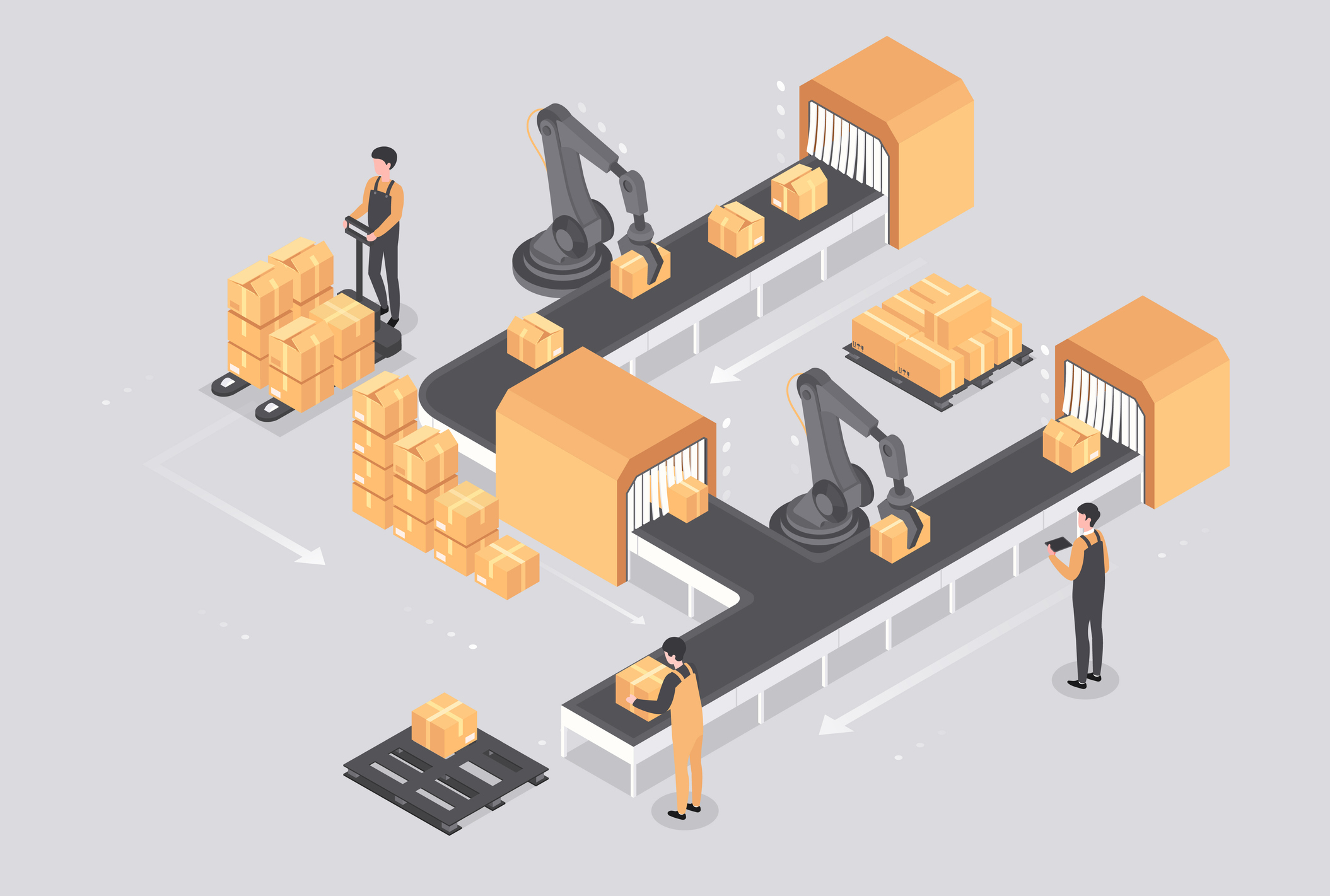Featured
8 Ways Contact Center Software Transforms Manufacturing and Supply Chain Communication
by Erina Suzuki | Published On December 13, 2022 | Last Updated July 8, 2025

Traditionally, manufacturing companies have focused on creating cost-effective production processes to compete in the global marketplace. However, in today's competitive environment, price alone is no longer a sufficient differentiator. To thrive, manufacturers must focus on delivering superior client experiences.
One way to achieve this is by leveraging omnichannel contact center solutions. Doing so lets manufacturers streamline communication, improve client satisfaction, and gain a competitive edge. From omnichannel capabilities to automated notifications, contact center tools can improve how manufacturers interact with their clients.
The Importance of Contact Centers in Manufacturing and Supply Chain Management
In the fast-paced world of manufacturing and supply chain management, effective communication:
Enhances communication across the supply chain
Manufacturing supply chains often involve multiple stakeholders, including raw material suppliers, production teams, logistics providers, and end clients. Miscommunication at any stage can lead to delays, increased costs, and client dissatisfaction. A contact center provides a centralized communication hub, ensuring all stakeholders are on the same page. Whether it’s resolving issues with a supplier or updating clients about shipment statuses, the contact center acts as the glue that holds the supply chain together.
Manages Time-Sensitive Communication
Manufacturing operations often deal with time-critical processes, such as delivering components for just-in-time (JIT) production. A contact center ensures swift and reliable communication, enabling manufacturers to respond to urgent inquiries and prevent costly production downtime. Automated notifications, for example, can alert suppliers to restocking needs in real time, while Interactive Voice Response (IVR) systems enable order tracking features to provide clients with immediate updates on shipments.
Enables Real-Time Visibility and Oversight
In manufacturing, real-time visibility into client interactions and service performance is critical for maintaining high standards and meeting deadlines. A contact center with real-time monitoring and analytics provides manufacturers with comprehensive oversight of their contact center operations.
For instance, these tools allow team leads to monitor key metrics such as call volumes, hold times, and agent performance. By analyzing trends in client inquiries or call patterns, manufacturers can proactively address service issues and improve client experiences. While a contact center monitoring tool does not provide direct visibility into the entire supply chain or production workflows, it ensures that the communication aspect of the supply chain is effectively managed and optimized.
8 Ways Contact Centers Transform Client Experiences
From managing production schedules to ensuring on-time deliveries, every step of the manufacturing and supply chain management depends on effective communication between manufacturers, suppliers, and clients. A robust contact center plays a vital role in this ecosystem, addressing communication challenges and optimizing workflows across the entire supply chain.
Explore several ways manufacturers can enhance client experiences with contact center solutions and why investing in this technology is a smart move for today’s manufacturing businesses.
1. Unify all communication channels within one platform
Manufacturing companies often have multiple service departments across different locations. This can lead to siloed communication, inefficient workflows, and inconsistent client experiences. By implementing a contact center platform, manufacturers can consolidate all communication channels, including voice, email, chat, and social media, into a single platform.
This centralized approach eliminates silos, enabling seamless collaboration between teams and consistent communication with clients. Whether your service teams are in different cities or countries, a unified contact center ensures that everyone has access to the same tools and information.
2. Build client relationships with personalization
In addition to consolidating communication channels onto a contact center platform, organizations may also integrate a Customer Relationship Management (CRM) tool. A CRM allows your service teams to access client information, including purchase history, contracts, and warranties, all in one place.
According to Salesforce, 72% of manufacturing service teams agree that a shared, single view of the customer is critical to their overall service process. Integrating a CRM with a contact center can help service teams have a single view of client information, enabling them to provide personalized experiences and build stronger client relationships.
3. Gain complete oversight of daily operations
Contact center platforms with real-time monitoring capabilities provide manufacturers with a comprehensive view of daily operations. Team leads can monitor key metrics such as call queues, agent performance, and client interaction history, all within a single dashboard. When clients call into your contact center platform, real-time monitoring tools can also notify the service team if certain thresholds have been exceeded.
These notifications are crucial because they enable service teams to respond quickly to potential bottlenecks, ensuring clients are not left waiting excessively or dissatisfied with the service. By addressing these issues proactively, businesses can prevent negative client experiences, maintain operational efficiency, and uphold high service standards. Real-time notifications empower teams to make timely adjustments, such as reallocating agents or prioritizing specific inquiries, to maintain smooth operations and client satisfaction.
Additionally, team leads can receive information on service employees’ performance, queues, and interactions. Implementing a real-time monitoring system allows you to assess daily performance and implement client service improvements where possible.
4. Embrace an omnichannel approach
While having multiple channels is a great way to reach clients through their preferred communication method, consider taking it to the next level with omnichannel contact center. Omnichannel contact centers not only allow clients to get connected on their preferred channels but also enable your service team to continue the conversation where it left off.
For example, if a client initiates a conversation via chat and later switches to a phone call, an omnichannel system ensures that the context of the conversation is retained. This continuity is especially valuable when addressing complex issues or follow-ups.
5. Prepare for disaster recovery and business continuity
Ensure your communication platform is up and running at all times. Maintaining communication with your clients is essential, especially when dealing with time-sensitive projects or urgent requests.
Contact centers that experience downtime can lead to communication breakdowns and create delays in project delivery. Therefore, be sure your contact center provider has a disaster response or contingency plan to avoid mishaps.
Providers offering 99.99% uptime minimize the risk of communication breakdowns, enabling smooth and uninterrupted project delivery. With a contingency plan in place, your organization can respond to time-sensitive projects and serve your clients effectively.
6. Streamline workloads with self-service options
Self-service options, such as interactive voice response (IVR) systems and chatbots, empower clients to resolve routine issues on their own. For example, a chatbot can handle inquiries about product availability or order status, allowing human agents to address more complex client needs. This not only improves client satisfaction but also frees up service teams to focus on high-priority cases.
Keep in mind that chatbots are not intended to replace humans completely. Instead, they can be useful for handling repetitive and routine tasks. For instance, chatbots can assist clients in submitting forms for warranty claims, service requests, or order modifications. Additionally, they can search databases to provide information such as product availability, pricing details, or order history. By automating these processes, chatbots free up service teams to focus on resolving more complex client needs.
7. Keep clients up to date with automated notifications
Proactive communication is key to maintaining strong client relationships. Automated outbound notifications keep clients informed about their order status, product updates, and other critical information throughout the manufacturing process.
By automating outbound notifications, you can ensure consistent, reliable information sharing with every client. Keeping your clients informed and up–to date before they contact you is a proactive way to maintain and strengthen their trust.
8. Reduce the number of transfers with skills-based routing
Implementing skills-based routing allows clients to be assigned to the appropriate agent based on their expertise. This way, clients calling in can reach the right employee, regardless of where employees are located and which department they belong to. For example, a client with a technical issue can be routed directly to a technical support specialist, eliminating unnecessary transfers. This approach not only saves time but also improves first-contact resolution rates.
By routing clients to the appropriate service employee, they can save time from unnecessary transfers and improve their satisfaction.
Conclusion
In today's fast-paced manufacturing industry, excellent client service is no longer a luxury—it's a necessity. Contact center software provides manufacturers with the tools they need to communicate effectively, streamline operations, and exceed client expectations.
By leveraging the strategies outlined above, your manufacturing organization can transform its approach to client service and gain a significant competitive edge. Don’t just compete—lead the way with innovative contact center solutions.
More from our blog
 Cloud contact centers provide an agile, scalable platform for customer service.
Cloud contact centers provide an agile, scalable platform for customer service.
 My journey with ComputerTalk began in the fall of 2019. As a recent university grad, I was looking for my first full-time job and came across a Marketing position posted by ComputerTalk to my school’s job search platform. I applied...
My journey with ComputerTalk began in the fall of 2019. As a recent university grad, I was looking for my first full-time job and came across a Marketing position posted by ComputerTalk to my school’s job search platform. I applied...
 This year, Ignite returned to Chicago for the first time since 2015, and that meant an even bigger venue, more days of content, and much better pizza!
This year, Ignite returned to Chicago for the first time since 2015, and that meant an even bigger venue, more days of content, and much better pizza!

